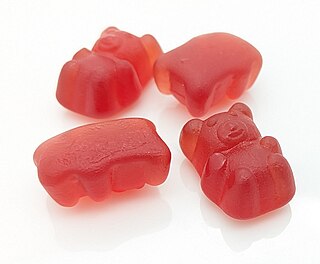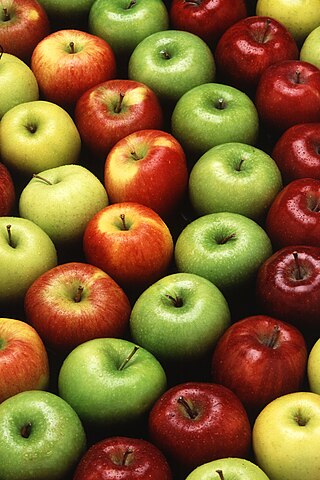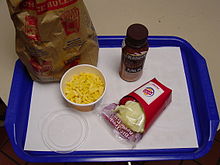
A carbohydrate is a biomolecule consisting of carbon (C), hydrogen (H) and oxygen (O) atoms, usually with a hydrogen–oxygen atom ratio of 2:1 and thus with the empirical formula Cm(H2O)n, which does not mean the H has covalent bonds with O. However, not all carbohydrates conform to this precise stoichiometric definition, nor are all chemicals that do conform to this definition automatically classified as carbohydrates.

Sucralose is an artificial sweetener and sugar substitute. As the majority of ingested sucralose is not metabolized by the body, it adds very little food energy. In the European Union, it is also known under the E number E955. It is produced by chlorination of sucrose, selectively replacing three of the hydroxy groups—in the C1 and C6 positions of the fructose portion and the C4 position of the glucose portion—to give a 1,6-dichloro-1,6-dideoxyfructose–4-chloro-4-deoxygalactose disaccharide. Sucralose is about 600 times sweeter than sucrose, 3 times as sweet as both aspartame and acesulfame potassium, and 2 times as sweet as sodium saccharin.

A sugar substitute is a food additive that provides a sweetness like that of sugar while containing significantly less food energy than sugar-based sweeteners, making it a zero-calorie or low-calorie sweetener. Artificial sweeteners may be derived through manufacturing of plant extracts or processed by chemical synthesis. Sugar substitute products are commercially available in various forms, such as small pills, powders, and packets.

Dietary fiber or roughage is the portion of plant-derived food that cannot be completely broken down by human digestive enzymes. Dietary fibers are diverse in chemical composition and can be grouped generally by their solubility, viscosity and fermentability which affect how fibers are processed in the body. Dietary fiber has two main subtypes: soluble fiber and insoluble fiber which are components of plant-based foods such as legumes, whole grains, cereals, vegetables, fruits, and nuts or seeds. A diet high in regular fiber consumption is generally associated with supporting health and lowering the risk of several diseases. Dietary fiber consists of non-starch polysaccharides and other plant components such as cellulose, resistant starch, resistant dextrins, inulins, lignins, chitins, pectins, beta-glucans, and oligosaccharides.

Diet sodas are soft drinks which contain little or no sugar or calories. First introduced onto the market in 1949, diet sodas are typically marketed for those with diabetes or who wish to reduce their sugar or caloric intake.

Maltodextrin is a name shared by two different families of chemicals. Both families are glucose polymers, but have little chemical or nutritional similarity.

Cat food is food specifically formulated and designed for consumption by cats. As obligate carnivores, cats have specific requirements for their dietary nutrients, namely nutrients found only in meat or synthesized, such as taurine and Vitamin A. Certain nutrients, including many vitamins and amino acids, are degraded by the temperatures, pressures and chemical treatments used during manufacture, and hence must be added after manufacture to avoid nutritional deficiency. Cat food is typically sold as dry kibble, or as wet food in cans and pouches.

A healthy diet is a diet that maintains or improves overall health. A healthy diet provides the body with essential nutrition: fluid, macronutrients such as protein, micronutrients such as vitamins, and adequate fibre and food energy.

Tagatose is a hexose monosaccharide. It is found in small quantities in a variety of foods, and has attracted attention as an alternative sweetener. It is often found in dairy products, because it is formed when milk is heated. It is similar in texture and appearance to sucrose :215 and is 92% as sweet,:198 but with only 38% of the calories.:209 Tagatose is generally recognized as safe by the Food and Agriculture Organization and the World Health Organization, and has been since 2001. Since it is metabolized differently from sucrose, tagatose has a minimal effect on blood glucose and insulin levels. Tagatose is also approved as a tooth-friendly ingredient for dental products. Consumption of more than about 30 grams of tagatose in a dose may cause gastric disturbance in some people, as it is mostly processed in the large intestine, similar to soluble fiber.:214

Polydextrose is a synthetic polymer of glucose. It is a food ingredient classified as soluble fiber by the US FDA as well as Health Canada, as of April 2013. It is frequently used to increase the dietary fiber content of food, to replace sugar, and to reduce calories and fat content. It is a multi-purpose food ingredient synthesized from dextrose (glucose), plus about 10 percent sorbitol and 1 percent citric acid. Its E number is E1200. The FDA approved it in 1981.

High-fructose corn syrup (HFCS), also known as glucose–fructose, isoglucose and glucose–fructose syrup, is a sweetener made from corn starch. As in the production of conventional corn syrup, the starch is broken down into glucose by enzymes. To make HFCS, the corn syrup is further processed by D-xylose isomerase to convert some of its glucose into fructose. HFCS was first marketed in the early 1970s by the Clinton Corn Processing Company, together with the Japanese Agency of Industrial Science and Technology, where the enzyme was discovered in 1965.

D-Psicose (C6H12O6), also known as D-allulose or simply allulose, is an epimer of fructose that is used by some commercial food and beverage manufacturers as a low-calorie sweetener. Allulose occurs naturally in small quantities in a variety of foods. It was first identified in the 1940s, although the enzymes needed to produce it on an industrial scale were not discovered until the 1990s.

Resistant starch (RS) is starch, including its degradation products, that escapes from digestion in the small intestine of healthy individuals. Resistant starch occurs naturally in foods, but it can also be added as part of dried raw foods, or used as an additive in manufactured foods.
A fat substitute is a food product with the same functions, stability, physical, and chemical characteristics as regular fat, with fewer calories per gram than fat. They are utilized in the production of low fat and low calorie foods.

A low-fat diet is one that restricts fat, and often saturated fat and cholesterol as well. Low-fat diets are intended to reduce the occurrence of conditions such as heart disease and obesity. For weight loss, they perform similarly to a low-carbohydrate diet, since macronutrient composition does not determine weight loss success. Fat provides nine calories per gram while carbohydrates and protein each provide four calories per gram. The Institute of Medicine recommends limiting fat intake to 35% of total calories to control saturated fat intake.

The Western pattern diet is a modern dietary pattern that is generally characterized by high intakes of pre-packaged foods, refined grains, red meat, processed meat, high-sugar drinks, candy and sweets, fried foods, industrially produced animal products, butter and other high-fat dairy products, eggs, potatoes, corn, and low intakes of fruits, vegetables, whole grains, pasture-raised animal products, fish, nuts, and seeds.

Weight management comprises behaviors, techniques, and physiological processes that contribute to a person's ability to attain and maintain a healthy weight. Most weight management techniques encompass long-term lifestyle strategies that promote healthy eating and daily physical activity. Weight management generally includes tracking weight over time and identifying an individual's ideal body weight.

Added sugars or free sugars are sugar carbohydrates added to food and beverages at some point before their consumption. These include added carbohydrates, and more broadly, sugars naturally present in honey, syrup, fruit juices and fruit juice concentrates. They can take multiple chemical forms, including sucrose, glucose (dextrose), and fructose.

Ultra-processed foods (UPFs) are industrially manufactured foods that are designed to be convenient, palatable, and affordable. These foods often contain multiple ingredients and additives such as preservatives, sweeteners, colorings, and emulsifiers, which are not typically found in home kitchens. They tend to be low in fiber and high in calories, salt, added sugar and fat, which are all related to poor health outcomes when eaten excessively. Common examples include packaged snacks, soft drinks, ready meals, and processed meats.



















